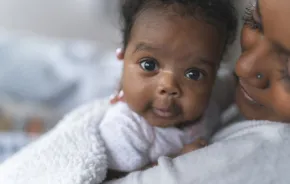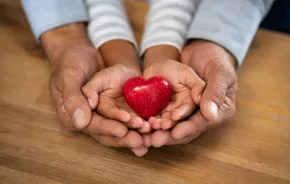A mother holds her baby in her lap, but the sound of a bird
makes Mom turn her head to see. Her baby looks first at Mom's face, and
then follows the direction of her mother's gaze toward that same bird.
Two people united by one focus.
This delicate moment may never get written down in a baby book. There's
no sticker on the Baby's First Year calendar for "follows Mom's gaze."
But Seattle scientist Andrew Meltzoff, Ph.D., recognizes it for a
milestone. He published a study explaining that this moment can predict
how well that same child will use words at age 2. The shared attention
signals a big accomplishment for the baby's brain.
When she notices her Mom's eyes point toward exciting things, she's
learning to synchronize her own gaze with that of her beloved mother.
That's a newly emerging milestone in the still-mysterious journey
toward language. This journey is not just about thinking but about
emotional connections, too.
Local research looks at how infants learn
The anatomy of that journey, in tiny step after tiny step, is the focus
of several research centers in Seattle, where early learning and infant
development have attracted federal grant money and private
philanthropy. For example, prominent philanthropists Bruce and Jolene
McCaw created Talaris Research Institute, after their experience as new
parents convinced them the world needed more information on the latest
neuroscience.
Talaris has partnered with public television stations across the
country to broadcast short educational messages about infant
development, and it also provides financial support to Meltzoff and
others in the Institute for Learning and Brain Science. In the plain
brick buildings behind the University of Washington Medical Center,
known as "I-labs," scientists see about 3,000 babies and children every
year. Bill Gates and his wife, Melinda, through their well-known
foundation, have promised donations of millions of dollars over several
years toward what the state calls its Early Learning Initiative.
Talaris has also invested in the research of the UW's John Gottman,
Ph.D., who is investigating how to strengthen couples as they face the
challenge of bringing a baby home.
"We have a confluence of world-class research... coupled with a
visionary philanthropic community and legislators in Olympia who have
really done their homework," Meltzoff says.
Whether new parents are overwhelmed with information or they are
curious beyond reason about baby neurons, this geographic area carries
clout in brainpower studying baby brains. Some of this is basic
science, trying to pinpoint the physical regions in the brain that
correspond to specific developmental steps in an infant's learning.
Other studies focus more on applying what is known to treat and support
families at risk. Still more is aimed at devising ways to educate the
public, and bring political muscle to changing how society views
youngsters.
Meltzoff and his wife, Patricia Kuhl, Ph.D., are co-directors of the
three-year-old Institute for Learning and Brain Science. The couple
might be best known for the book they co-wrote with Alison Gopnick,
Ph.D., The Scientist in the Crib. They compared themselves as
scientists looking through the crib bars, to the powerful
scientist-infant looking back out.
Amazing techniques that allow live images of a brain's activity, as
well as sensors of the brain's electrical signals, are opening windows
into the unique abilities of the infant brain. Rather than see it as an
empty vessel, filled slowly with experience, research suggests that the
infant brain is a dynamic analyzer from the earliest moments of life.
The institute has five main themes of its research: milestones of
learning; the brain's plasticity and mechanisms of change; the links
connecting brain and behavior; nature and nurture; and the links
between computer learning and biological learning.
"Every month, a faculty member, post-doc, or graduate student discovers something we did not know before," Meltzoff says.
Kuhl and Meltzoff are just two among a host of local luminaries who are
conducting research on child development and emerging public policy and
putting that knowledge to use. Walk across some lawns from their
Institute, and you'll find another star, Kathryn Barnard, R.N., Ph.D.,
who applies neuroscience findings to help identify infants and others
at risk. Several years ago, Barnard received the Institute of
Medicine's prestigious Lienhard Award, a national honor given for
discoveries in infant development.
Barnard studies the bond between mother and child. A difficult
pregnancy, a premature birth or the trauma of poverty or abuse can
weaken that bond. A mother who is depressed, for example, may not
respond typically to her baby's needs, and that baby may become loud
and difficult to console, caught in a spiral that makes the mother less
and less confident.
As director of the UW's Center for Infant Mental Health, Barnard hopes
to apply some of the discoveries about infants to rescuing them from
damage in their early years. Although she has plans to retire later
this year, she feels very cheered by the momentum built up in this
state. She's been an advisor, along with others noted here, to the
State of Washington for several years, helping to develop the Early
Learning Initiative that Gov. Christine Gregoire signed into law in
February. That initiative will focus more state resources on children
younger than school age, and will try to set standards for
higher-quality care in preschools. Details are still being worked out
on precisely how the state will work with a public-private partnership
to improve early learning. According to Talaris spokeswoman Cherylynne
Crowther, the partnership has chosen the name "Thrive by Five."
What Barnard's center does is help train therapists to work with all
sorts of parents, from teen mothers to mothers who have suffered
traumas, to try to help them harmonize with their growing babies. One
of the tools they use looks like a game: a set of cards called
"BabyCues: A child's first language."
On each glossy card is face after delightful face, some smiling and
some looking shy, but every one chosen by the researchers as an example
of a cue that a caregiver should be able to understand. When therapists
work with parents, they ask them to sort these cards -- one pile for
faces that seem to be saying "yes," and the other for faces that seem
to be saying "no." For example, a baby on a card is putting her hands
in her mouth. Barnard says that is a signal that she wants to take a
break, what researchers call disengagement. On the back, each card
explains the cue given by the child's face. Some cues are subtle and
some are more obvious. The crying face definitely says "I need a
break." Each card illustrates either engagement or disengagement.
Parents who easily recognize cues will know what their infant wants or
needs and will have an easier job of parenting. They will learn their
baby's rhythms and feel confident in their own ability, and that is
central to the baby's own healthy development.
"If I had a soapbox," Barnard says, "I would stand up and say: Talk to
your baby." She doesn't mean trying to force information on the infant
in an artificial way, but rather giving in to the natural sing-song
patter that babies seem to love.
In her laboratory, Kuhl calls that natural way of speaking to babies
"motherese" or "parentese." She found in research across different
cultures worldwide that this parent patter is remarkably similar, even
in different languages. The exaggeration that comes naturally to adults
when talking to babies appears to help them analyze and the babies begin to
understand language.
What Kuhl and others study on a typical day in the lab might appear
quite ordinary on the surface. A mother and child sit in a comfy chair
while researchers play sounds into headphones for the child.
Cutting-edge technology shares space with toys and changing tables.
Stretch caps in pastel colors hang over the changing table here. Each
cap has a rainbow-colored computer ribbon cable trailing from it like a
comet's tail. When a baby wears the cap, the child's brain is being
monitored by between 22 and 32 sensors that pick up brain activity in
the form of ERP, or event-related brain potential. Think of the caps as
listening and mapping the electrical activity in the brain. Each cap is
plugged into software that records the session, noting with precision
where in the brain the activity spiked and at precisely what sound.
It is just these hours and hours of observation that led Kuhl several
years ago to a conclusion that has had wide reverberations. She found
that 6-month-old babies, exposed to some unique sounds in a foreign
language, could distinguish the same sounds accurately years later.
Similar infants who were not exposed lost the ability to distinguish
these sounds by about a year of age.
Kuhl has called the younger babies "citizens of the world" because
their brains seem capable of distinguishing any language. However, if
the baby is not exposed to more than one language, it appears to narrow
its focus and become specialized in only its native tongue.
In an article in Time magazine in January, Kuhl argued that many CDs
and DVDs sold as "educational" for babies might be missing another
important element of this equation. When she played recordings of
Mandarin for babies in her speech research, they did not seem to
perceive the special sounds of the language as well as babies who had a
living, breathing human speaking that language to them. The bottom
line: People are the best teachers.
"We can't buy any toy that replaces the value of the social-emotional
interaction with the baby," Meltzoff points out. "Some baby books and
scientific theories tend to separate the mental and the emotional, but
in real, live, hot-blooded human beings, emotions and thoughts weave
together. We are 'in the flow' when both mind and heart are working
seamlessly together."
Barnard likes to make much the same point for parents in a different
way. She tells them that cuddling and talking to a baby bathes her in a
rich sensory bath. The baby feels the warm touch of the parent's arms
and chest, inhales the smell of the familiar, feels the beat of the
parent's heart, hears the cooing sounds of a voice, and sees the lively
face above. In the cold language of the lab, this stimulates visual,
tactile, auditory and olfactory systems. Plastic toys and television
programs don't provide that rich bath of sensation or the emotional
connection with a loving person.
"You are your baby's favorite play-thing," Meltzoff concludes.
Babies and language: from lab to neighborhood
The Sponge School opened in
November 2005. With a 10-week pilot program, Mighdoll quickly signed up
about 140 families for the school, located in the Mount Baker
neighborhood.
Parents bring babies as young as 31/2 months to the weekly sessions,
where they hear and sing one of four languages -- Japanese, Mandarin,
Spanish and French -- from teachers who are native speakers. During the
roughly hour-long sessions at Sponge, teachers lead the children and
parents in singing, dancing, play with puppets, and other immersion in
phrases from the language.
"I created the school because I had read about Kuhl's research and that
of others," explains Mighdoll, who was pregnant at the time with her
son. "There was a gap in what services were offered for the very
young." Her son, now age 2, attends classes in both Japanese and
Mandarin.
Mighdoll brings a variety of life experiences, including growing up in
bilingual Canada and time teaching in Japan, to her passion for
language and culture. She has master's degrees in business and
international studies.
"We are creating a love of language and culture," in the children, she
says. The emphasis at Sponge, she adds, is not on children's
proficiency with the target language, but rather their exposure to a
natural and playful environment where they hear a native speaker.
Sally James is a Seattle freelance writer and mother of three.
Infant brain research resources:
- Talaris Research Institute
-
Institute for Learning and Brain Science
- National Child Care Information Center -- comprehensive resource list on brain research.
-
Center on Infant Mental Health
Books:
- Baby Minds: Brain-building games your baby will love, by Linda Acredolo, Ph.D. and Susan Goodwyn, Ph.D.
-
The Scientist in the Crib: What early learning tells us about the mind,
by Alison Gopnick, Ph.D., Andrew Meltzoff, Ph.D. and Patricia Kuhl,
Ph.D. Inspired by the research of Patricia Kuhl, Ph.D., at the
University of Washington, and studies from elsewhere in the U.S.,
Seattle mother and businesswoman Jackie Friedman Mighdoll started a
language school for babies and children up to age five.
Originally published in the April, 2006 print edition of ParentMap.









